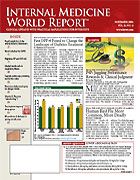Physicians Undertreating Many Patients with Steroid-induced Osteoporosis
Physicians Undertreating Many Patients with Steroid-induced Osteoporosis
By Charles Bankhead
Seattle—Despite the existence of national and international guidelines for the management of glucocorticoid-induced osteoporosis, only a minority of chronic steroid users receive treatment for this condition, according to a study presented at the American Society of Bone and Mineral Research annual meeting.
Data for this study were taken from an earlier review of records from a large managed company (J Rheumatology. 2001;28:1298-1305), which showed that less than one half of women and a quarter of men were being screened or treated for GIOP.
“Evidence suggests that early and rapid bone loss occurs with the initiation of glucocorticoid therapy,” said Jeffrey Curtis, MD, MPH, of the University of Alabama at Birmingham. “New users need to be highlighted as being at particular risk. African Americans and men also are at increased risk compared with nonusers.”
About 1% of the population is receiving chronic glucocorticoid therapy, which has been associated with fracture rates as high as 40% in observational studies of select populations with extended follow-up, Dr Curtis noted.
“Guidelines issued by US and international agencies provide for bone mineral density [BMD] measurement and preventive therapy for high-risk individuals,” he said. “Despite these recommendations, screening with bone mineral measurement and prescription of osteoporosis medications has generally been low in studies that have examined the issue. Bone mineral measurement is often provided to fewer than 1 in 5 patients receiving chronic glucocorticoid therapy, and rates of calcium supplementation and bisphosphonate use have been similarly low.”
In a study that evaluated clinical practices between 1995 and 1998, the Birmingham group found rates of screening and treatment for glucocorticoid-induced osteoporosis to be <50% overall, although rates varied by physician specialty. The current study covered the period of 2001 to 2003 and was compared with results from the initial review period.
Evaluated were the records of 6517 chronic steroid users, including 5641 who started therapy during the review period. Chronic use was defined as ³60-day use of filled prescriptions. The mean age of the study population was 50 years, and the patients had an average of 7 comorbid conditions. Daily steroid dose averaged 16 mg of prednisone (Meticorten)or equivalent. Surveys returned by 2300 patients showed that 40% were not taking calcium or vitamin D supplements.
The analysis showed that 20% of men had some type of BMD assessment documented in their records. Among women aged <50 years, 34% underwent screening, and 46% of women aged ³50 years had some type of BMD assessment in their records. Although the screening rates were low, they nonetheless represented an improvement over 1995 to 1998 (Table).
Use of hormonal or other bone protective medications was seen in 23% of men, 33% of women aged <50 years, and 62% of women aged ³50 years. Alhough still suboptimal, the rates represented absolute improvement of 15% to 20% per group compared with the earlier period reviewed. Dr Curtis reported that 15% of men, 16% of younger women, and 31% of older women received bisphosphonate therapy. Still low, the rates constituted 2- to 4-fold improvement from 1995 to 1998. Rates of medication use increased in a linear fashion across all age groups of women but were relatively flat across the age spectrum of men, he added.
African Americans and other minorities were less likely to be screened or to receive medication for this type of osteoporosis.
“We see that the longitudinal trends in glucocorticoid-induced osteoporosis management show relative improvement over time, but the absolute rates are still suboptimal,” said Dr Curtis. “This leads us to challenges and opportunities for improvement.”
